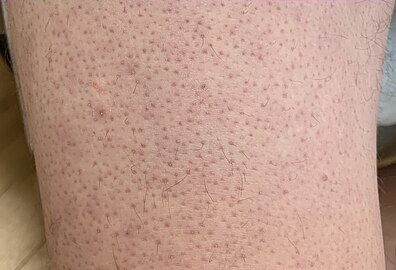Keratosis pilaris
| Keratosis pilaris | |
|---|---|
| Other names | Follicular keratosis, lichen pilaris |
 | |
| Condition on a calf | |
| Specialty | Dermatology |
Keratosis pilaris (KP; also follicular keratosis, lichen pilaris, or colloquially chicken skin.
The several types of KP have been associated with
The cause of KP is not completely understood. As of 2018, KP is thought to be due to abnormalities in the process of depositing the protein
KP is the most common disorder of the hair follicle in children.[1]
How common it is in adults is unclear since keratosis pilaris is an underreported condition and the actual prevalence of the condition may be higher than estimated.
Signs and symptoms
KP results in small, rough bumps on the surface of the skin. They are skin-colored bumps the size of a grain of sand, many of which are surrounded by a slight pink color in light-skinned people and dark spots in dark-skinned people.
Though people with KP experience the condition year-round, the problem can become exacerbated, with the bumps likely to look and feel more pronounced in color and texture, during the colder months, when moisture levels in the air are lower.[8] The symptoms may also worsen during pregnancy or after childbirth.[9] Increased sun exposure might mitigate the symptoms of KP. [citation needed]
Pathophysiology
KP occurs when the human body produces excess amounts of the skin protein keratin, resulting in the formation of
KP subtypes are occasionally part of genetically inherited syndromes associated with
Diagnosis
Physicians can often diagnose KP simply by examining the skin without specialized tests,
Differential diagnosis
Several medications that can cause a skin eruption similar to KP include
Classification
The several different types of KP include KP rubra (red, inflamed bumps, which can be on arms, head, legs), KP alba (rough, bumpy skin with no irritation), KP rubra faceii (reddish rash on the cheeks), KP atrophicans, keratosis follicularis spinulosa decalvans, atrophoderma vermiculatum, KP atrophicans faciei, erythromelanosis follicularis faciei et colli, and papular profuse precocious KP.[1][7]
KP is commonly described in association with other dry-skin conditions, such as ichthyosis vulgaris, dry skin, and atopic dermatitis, including those of asthma and allergies.
Gallery
-
Keratosis Pilaris on Back
-
Keratosis pilaris on lower extremity
-
Keratosis pilaris on back of upper arm
-
Keratosis pilaris on arm
-
Skin plugs removed from a person with keratosis pilaris
Treatment
KP is medically harmless,[2] but many individuals may seek treatment, as the condition can cause emotional distress.[9] Topical creams and lotions are currently the most commonly used treatment for KP, specifically those consisting of moisturizing or keratolytic treatments, including urea, lactic acid, glycolic acid, salicylic acid, vitamin D, fish oil, or topical retinoids such as tretinoin.[12] Improvement of the skin often takes months, and the bumps are likely to return. Limiting time in the shower and using gentle exfoliation to unplug pores can help.[9][13] Many products are available that apply abrasive materials, with alpha or beta hydroxy acids to assist with exfoliation.
Some cases of KP have been successfully treated with
Epidemiology
Worldwide, KP affects an estimated 30 to 50% of the adult population, and around 50 to 80% of all
See also
References
- ^ S2CID 51715063.
- ^ PMID 25748313.
- ^ Alai, Nili. "Keratosis Pilaris (KP)". MedicineNet. Retrieved 2008-10-06.
- ^ a b c d e Berman, Kevin. "Keratosis pilaris". MedlinePlus. Retrieved 2008-06-19.
- PMID 30066947.
- PMID 31536314.
- ^ PMID 18856156.
- ^ "Keratosis pilaris ("chicken skin")". NHS Choices. 2017-10-24.
- ^ a b c d "Keratosis pilaris: Self-management". Mayo Clinic.
- ^ Mayo Clinic Staff. "Tests and Diagnosis". Mayo Clinic. Retrieved 2013-10-31
- ^ a b Alai, Nili; Arash Michael Saemi; Raul Del Rosario. "Keratosis Pilaris". eMedicine. Medscape (WebMD). and "Pathophysiology". Medscape (WebMD). Retrieved February 5, 2018.
- ^ PMID 17504714.
- ^ Mayo Clinic Staff (5 January 2016). "Self-management - Keratosis Pilaris". mayoclinic.org. Mayo Foundation. Retrieved 11 April 2016.
- S2CID 32102128.
External links
- The American Academy of Dermatology
- The American Osteopathic College of Dermatology - Article on keratosis pilaris





